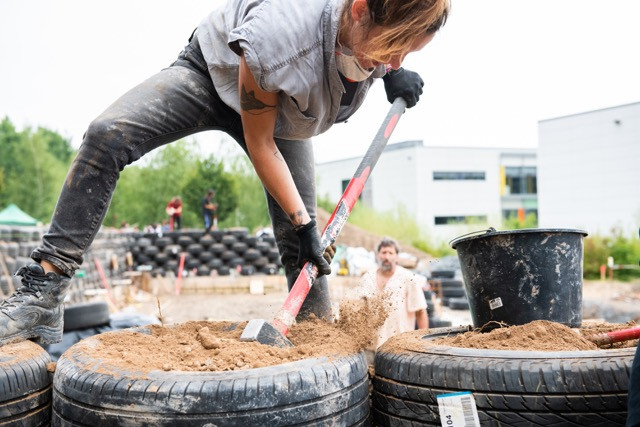During the summer, scores of European and local volunteers spent up to four weeks in Redange-sur-Atert to begin, in the west of Luxembourg, working on the ecological learning centre. But, the bricks they used were not the kind you’d find on an average building site. Drawing closely on the same principles of the Earthships pioneered by Michael Reynolds, Cell’s Äerdschëff is built with repurposed and sustainable materials, like used tyres, pounded with earth.
“One thing I found surprising in Luxembourg is that the tyres are all very new, still,” Deborah Binder, one of the Earthship experts laughs. This is the twenty-sixth earthship Binder has worked on, having built others in the US, and as part of disaster relief efforts in the Philippines and in Puerto Rico. She adds that she is increasingly seeing people build earthships as private homes.
“Homes or buildings still account for a big amount of the consumption of fossil fuels in the world. If we can reduce that, then we’re making a huge impact,” Binder says, adding: “Especially buildings like this that is not just someone’s personal home, but that’s going to be a community centre that will have an impact on so many people and will help educate and re-educate people to live more sustainably, is incredible.”

Rob Hirsch, pictured top right, is an Earthship expert who directs the construction work. Photo: LaLa La Photo
Sustainability as necessity
Delano visits on 14 August, a few days after a tornado struck the communes of Rodange and Käerjeng, in the south of Luxembourg. The same day a tornado struck Amsterdam in the Netherlands. These extreme weather incidents show the importance of exploring construction methods which recycle and repurpose old materials, says Cell project coordinator Rodrigo Vergara. “These are the side effects of global warming we should be waking up to. We will get to the point where the choice won’t be there anymore, it will become a necessity,” Vergara said.
The first international volunteers arrived at the site on 29 July where they were housed in the dormitories at the Lycée Atert and spent a week preparing the materials, including the tyres and the glass bottles, which were cut for the windows. The physical work began on 5 August when a crew of Earthship experts joined them to start on the tyre wall. While volunteer numbers were lower than during the first days when they reached 45, everyone still there wore a smile, even if they were tired.
“Someone said this expression ‘happy tired’, this is I think the motto of our project,” Yordanka Dimcheva, from Bulgaria, tells me during breakfast. “Because everyone is happy because of the team but at the same time tired because of the work.”
When the team begins working at 8:30am, Ariana, a volunteer from Italy who pounds tyres while we talk, explains that playing music helps to keep her motivated as does the team spirit. “If you see someone that’s motivated and has a lot of energy, it transmits a lot of energy and you start pounding together and you dance and sing,” she says. “And there’s the party stick,” Alejandra, a volunteer from Spain pipes up, pointing to the spirit level. “We call it the party stick because when your tyre is level and you see the bubble, you’re so happy, you want to party!”

Äerdschëff volunteers clean up after the last meal. Photo: LaLa La Photo
Building a community
The on-site volunteers are energetic, despite the fact that the night before they stayed up late, celebrating the last day at the site of Mattias Schwaitzer, an Italian volunteer who has been with Cell for the last year.
“I worked one year for this to happen and now I’m not even able to go there and pound tyres. But it’s quite good, it’s like a dream come true so it’s quite nice it’s happening,” Schwaitzer tells Delano.
In addition to the construction, volunteers were responsible for sharing tasks such as cleaning and meal preparation. In a sheltered part of the high school, they constructed a small “village”, with a marquee to house a fridge and their food, an outdoor kitchen area with stove and sink and a chill out area, where some of the tyres were being used as seating.
Vergara explains this is the longest community project that Cell has embarked on. Its success, he said was largely down to the volunteers. “The volunteers we have are incredible also because, keeping in mind none of them knew each other. So, they came here and without any conflicts, they stuck together, and they really made a community out of it. This is one of the nicest aspects of the whole thing,” he says.
The Äerdschëff learning centre is expected to be completed in 2020 when it will also provide accommodation for two Cell volunteers.
